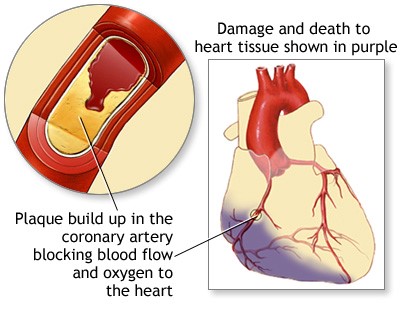Coronary heart disease
Contents
Coronary heart disease (CHD) is a narrowing of the small blood vessels that supply blood and oxygen to the heart. CHD is also called coronary artery disease.
Causes
Coronary heart disease (CHD) is the leading cause of death in the United States for men and women.
Coronary heart disease is caused by the buildup of plaque in the arteries to your heart. This may also be called hardening of the arteries.
- Fatty material and other substances form a plaque build-up on the walls of your coronary arteries. The coronary arteries bring blood and oxygen to your heart.
- This buildup causes the arteries to get narrow.
- As a result, blood flow to the heart can slow down or stop.
A risk factor for heart disease is something that increases your chance of getting it. You cannot change some risk factors for heart disease, but others you can change.

Image to be added
A heart attack or acute myocardial infarction (MI) occurs when one of the arteries that supplies the heart muscle becomes blocked. Blockage may be caused by spasm of the artery or by atherosclerosis with acute clot formation. The blockage results in damaged tissue and a permanent loss of contraction of this portion of the heart muscle.
Symptoms may be very noticeable, but sometimes you can have the disease and not have any symptoms. This is especially true in the early stages of heart disease.
Chest pain or discomfort (angina) is the most common symptom. You feel this pain when the heart is not getting enough blood or oxygen. How bad the pain is varies from person to person.
- It may feel heavy or like someone is squeezing your heart. You may feel it under your breast bone (sternum), but also in your neck, arms, stomach, or upper back.
- The pain usually occurs with activity or emotion, and goes away with rest or a medicine called nitroglycerin.
- Other symptoms include shortness of breath and fatigue with activity (exertion).
Women, elderly people, and people with diabetes are more likely to have symptoms other than chest pain, such as:
- Fatigue
- Shortness of breath
- General weakness
Exams and Tests
Your doctor or nurse will examine you. Your doctor will often order more than one test before making a diagnosis.
Tests may include:
Coronary angiography -- an invasive test that evaluates the heart arteries under x-ray
Echocardiogram stress test
Electrocardiogram (ECG)
Electron-beam computed tomography (EBCT) to look for calcium in the lining of the arteries -- the more calcium, the higher your chance for CHD
Exercise stress test
Heart CT scan
Nuclear stress test
Treatment
You may be asked to take one or more medicines to treat blood pressure, diabetes, or high cholesterol levels. Follow your doctor's directions closely to help prevent coronary artery disease from getting worse.
Goals for treating these conditions in people who have coronary artery disease:
Blood pressure less than or equal to 140/90 (even lower for patients with diabetes, kidney disease, or heart failure)
HbA1c levels if you have diabetes at a level recommended by your doctor
LDL cholesterol level less than or equal to 100 mg/dL (even lower for some patients)
Treatment depends on your symptoms and how severe the disease is. Your doctor may give you one or more medicines to treat heart disease, blood pressure, diabetes, or high cholesterol. Follow your doctor's directions closely to help prevent coronary artery disease from getting worse.
Never stop taking your medicines without talking to your doctor first. Stopping heart medicines suddenly can make your angina worse or cause a heart attack.
Your doctor may refer you to a cardiac rehabilitation program to help improve your heart's fitness.
Procedures and surgeries used to treat CHD include:
Angioplasty and stent placement, called percutaneous coronary interventions (PCIs)
Coronary artery bypass surgery
Minimally invasive heart surgery
Outlook (Prognosis)
Everyone recovers differently. Some people can maintain a healthy life by changing their diet, stopping smoking, and taking medications exactly as the doctor prescribes. Others may need medical procedures such as angioplasty or surgery.
Although everyone is different, early detection of CHD generally results in a better outcome.
When to Contact a Medical Professional
If you have any risk factors for CHD, contact your doctor to discuss prevention and possible treatment.
Immediately contact your health care provider, call the local emergency number (such as 911), or go to the emergency room if you have:
Angina or chest pain
Shortness of breath
Symptoms of a heart attack
Source: http://www.nlm.nih.gov/medlineplus/ency/article/007115.htm

